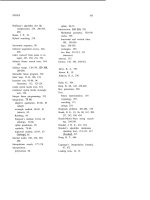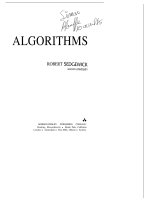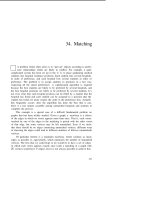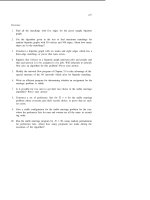Tài liệu Thuật toán Algorithms (Phần 21) pptx
Bạn đang xem bản rút gọn của tài liệu. Xem và tải ngay bản đầy đủ của tài liệu tại đây (92.25 KB, 10 trang )
BALANCED TREES
193
The “slant” of each 3-node is determined by the dynamics of the algorithm
to be described below. There are many red-black trees corresponding to each
2-3-4 tree. It would be possible to enforce a rule that 3-nodes all slant the
same way, but there is no reason to do so.
These trees have many structural properties that follow directly from the
way in which they are defined. For example, there are never two red links in
a row along any path from the root to an external node, and all such paths
have an equal number of black links. Note that it is possible that one path
(alternating black-red) be twice as long as another (all black), but that all
path lengths are still proportional to 1ogN.
A striking feature of the tree above is the positioning of duplicate keys.
On reflection, it is clear that any balanced tree algorithm must allow records
with keys equal to a given node to fall on both sides of that node: otherwise,
severe imbalance could result from long strings of duplicate keys. This implies
that we can’t find all nodes with a given key by repeated calls to the searching
procedure, as in the previous chapter. However, this does not present a real
problem, because all nodes in the subtree rooted at a given node with the
same key as that node can be found with a simple recursive procedure like
the treeprint procedure of the previous chapter. Or, the option of requiring
distinct keys in the data structure (with linked lists of records with duplicate
keys) could be used.
One very nice property of red-black trees is that the treesearch procedure
for standard binary tree search works without modification (except for the
problem with duplicate keys discussed in the previous paragraph). We’ll
implement the link colors by adding a boolean field red to each node which is
true if the link pointing to the node is red, false if it is black; the treesearch
procedure simply never examines that field. That is, no “overhead” is added
by the balancing mechanism to the time taken by the fundamental searching
procedure. Each key is inserted just once, but might be searched for many
times in a typical application, so the end result is that we get improved search
times (because the trees are balanced) at relatively little cost (because no work
for balancing is done during the searches).
Moreover, the overhead for insertion is very small: we have to do some-
thing different only when we see 4-nodes, and there aren’t many 4-nodes in
the tree because we’re always breaking them up. The inner loop needs only
one extra test (if a node has two red sons, it’s a part of a 4-node), as shown
in the following implementation of the insert procedure:
194
CHripTER 15
function rbtreeinsert(v: integer; x:Jink) : link;
var gg,
g,
f: link;
begin
f:=x; g:=x;
repeat
gg:=g; g:=f; f:=x;
if v<xf.key then x:=xf.J else
x:=xf.r;
if xt.Jt.red and
xt.rt.red
then x:=spJit(v, gg, g,
f,
x);
until x=8;
new(x); xt.key:=v; xt.J:=z; xt.r:=z;
if v<f/.key then f/.J:=x else Q.r:=x;
rbtreeinsert:=x;
x:=spJit(v, gg, g,
f,
x);
end
;
In this program, x moves down the tree as before, with gg, g, and f kept
pointing to x’s great-grandfather, grandfather, and father in the tree. To see
why all these links are needed, consider the addition of Y to the tree above.
When the external node at the right of the 3-node containing S and X is
reached, gg is R, g is S, and f is X. Now, Y must be added to make a 4-node
containing S, X, and Y, resulting in the following tree:
We need a pointer to R (gg) because R’s right link must be changed to point
to X, not S. To see exactly how this comes about, we need to look at the
operation of the split procedure.
To understand how io implement the split operation, let’s consider the
red-black representation for the two transformations we must perform: if we
have a 2-node connected to a 4-node, then we should convert them into a
BALANCED TREES
195
3-node connected to two
a-nodes;
if we have a S-node connected to a 4-node,
we should convert them into a 4-node connected to two 2-nodes. When a
new node is added at the bottom, it is considered to be the middle node of
an imaginary 4-node (that is, think of
a
as being red, though this never gets
explicitly tested).
The transformation required when we encounter a a-node connected to a
4-node is easy:
This same transformation works if we have a 3-node connected to a 4-node in
the “right” way:
Thus, split will begin by marking x to be red and the sons of x to be black.
This leaves the two other situations that can arise if we encounter a S-node
connected to a 4-node:
196
CHAPTER 15
g
f
X
6
*
?
(Actually, there are four situations, since the mirror images of these two can
also occur for S-nodes of the other orientation.) In these cases, the split-up of
the 4-node has left two red links in a row, an illegal situation which must be
corrected. This is easily tested for in the code: we just marked x red; if x’s
father f is also red, we must take further action. The situation is not too bad
because we do have three nodes connected by red links: all we need to do is
transform the tree so that the red links point down from the same node.
Fortunately, there is a simple operation which achieves the desired effect.
Let’s begin with the easier of the two, the third case, where the red links
are oriented the same way. The problem is that the 3-node was oriented the
wrong way: accordingly, we restructure the tree to switch the orientation of
the 3-node, thus reducing this case to be the same as the second, where the
color flip of x and its sons was sufficient. Restructuring the tree to reorient a
S-node involves changing three links, as shown in the example below:
BALANCED TREES
197
In this diagram,
TI
represents the tree containing all the records with keys
less than A,
Tz,
contains all the records with keys between A and B, and so
forth. The transformation switches the orientation of the S-node containing
A and B without disturbing the rest of the tree. Thus none of the keys in
TI,
Tz,
T3,
and
T,
are touched. In this case, the transformation is effected by
the link changes
st.l:=gsf.r;
gst.r:=s; yt.l:=gs. Also, note carefully that the
colors of A and B are switched. There are three analogous cases: the 3-node
could be oriented the other way, or it could be on the right side of y (oriented
either way).
Disregarding the colors, this single rotation operation is defined on any
binary search tree and is the basis for several balanced tree algorithms. It is
important to note, however, that doing a single rotation doesn’t necessarily
improve the balance of the tree. In the diagram above, the rotation brings
all the nodes in
Tl
one step closer to the root, but all the nodes in
T3
are
lowered one step. If
T3
were to have more nodes than
Tl,
then the tree after
the rotation would become less balanced, not more balanced. Top-down 2-3-4
trees may be viewed as simply a convenient way to identify single rotations
which are likely to improve the balance.
Doing a single rotation involves structurally modifying the tree, some-
thing that should be done with caution. A convenient way to handle the four
different cases outlined above is to use the search key v to “rediscover” the
relevant son (s) and grandson (gs) of the node y. (We know that we’ll only be
reorienting a 3-node if the search took us to its bottom node.) This leads to
somewhat simpler code that the alternative of remembering during the search
not only the two links corresponding to s and gs but also whether they are
right or left links. We have the following function for reorienting a 3-node
along the search path for v whose father is y:
function rotate(v: integer; y: link): link;
var
s,gs:
link;
begin
if v<yt.key then
s:=yf.l
else s:=yf.r;
if
v<
st
. key
then begin gs:=sf.l;
st.l:=gsf.r;
gst.r:=s
end
else begin gs:=st.r;
sf.r:=gsf.l;
gsf.I:=s end;
if v<yt.key then
yf.l:=gs
else yf.r:=gs;
rotate:=gs
end
;
If
s
is the left link of y and gs is the left link of s, this makes exactly the link
transformations for the diagram above. The reader may wish to check the
198
CHAPTER 15
other cases. This function returns the link to the top of the S-node, but does
not do the color switch itself.
Thus, to handle the third case for split, we can make g red, then set x to
rotate(v,gg), then make x black. This reorients the 3-node consisting of the
two nodes pointed to by g and f and reduces this case to be the same as the
second case, when the 3-node was oriented the right way.
Finally, to handle the case when the two red links are oriented in different
directions, we simply set f to rotate(v, g). This reorients the “illegal” S-node
consisting of the two nodes pointed to by f and x. These nodes are the same
color, so no color change is necessary, and we are immediately reduced to
the third case. Combining this and the rotation for the third case is called a
double rotation for obvious reasons.
This completes the description of the operations which must be performed
by split. It must switch the colors of x and its sons, do the bottom part of a
double rotation if necessary, then do the single rotation if necessary:
function split(v: integer; gg, g,
f,
x: link): link;
begin
xf.red:=true;
xt.lf.red:=false;
xf.rt.red:=false;
if ft.red then
begin
gf.red:=
true;
if (v<gf.key)<> (v<fi.key) then f:=rotate(v, g);
x:=rotate(v, gg);
xf.red:=false
end
;
headf.rf.red:=false;
split:=x
end
;
This procedure takes care of fixing the colors after a rotation and also restarts
x high enough in the tree to ensure that the search doesn’t get lost due
to all the link changes. The long argument list is included for clarity; this
procedure should more properly be declared local to rbtreeinsert, with access
to its variables.
If the root is a 4-node then the split procedure will make the root red,
corresponding to transforming it, along with the dummy node above it into a
3-node. Of course, there is no reason to do this, so a statement is included at
the end of split to keep ihe root black.
Assembling the code fragments above gives a very efficient, relatively
simple algorithm for insertion using a binary tree structure that is guaranteed
BALANCED TREES
to take a logarithmic number of steps for all searches and insertions. This
is one of the few searching algorithms with that property, and its use is
justified whenever bad worst-case performance simply cannot be tolerated.
Furthermore, this is achieved at very little cost. Searching is done just as
quickly as if the balanced tree were constructed by the elementary algorithm,
and insertion involves only one extra bit test and an occasional split. For
random keys the height of the tree seems to be quite close to 1gN (and only
one or two splits are done for the average insertion) but no one has been able
to analyze this statistic for any balanced tree algorithm. Thus a key in a file
of, say, half a million records can be found by comparing it against only about
twenty other keys.
Other Algorithms
The “top-down 2-3-4 tree” implementation using the “red-black” framework
given in the previous section is one of several similar strategies than have
been proposed for implementing balanced binary trees. As we saw above, it
is actually the “rotate” operations that balance the trees: we’ve been looking
at a particular view of the trees that makes it easy to decide when to rotate.
Other views of the trees lead to other algorithms, a few of which we’ll mention
briefly in this section.
The oldest and most well-known data structure for balanced trees is the
AVL tree. These trees have the property that the heights of the two
subtrees
of each node differ by at most one. If this condition is violated because of
an insertion, it turns out that it can be reinstated using rotations. But this
requires an extra loop: the basic algorithm is to search for the value being
inserted, then proceed
up
the tree along the path just travelled adjusting the
heights of nodes using rotations. Also, it is necessary to know whether each
node has a height that is one less than, the same, or one greater than
t,he
height of its brother. This requires two bits if encoded in a straightforward
way, though there is a way to get by with just one bit per node.
A second well-known balanced tree structure is the
2-3
tree, where only
2-nodes and 3-nodes are allowed. It is possible to implement insert using an
“extra loop” involving rotations as with AVL trees, but there is not quite
enough flexibility to give a convenient top-down version.
In Chapter 18, we’ll study the most important type of balanced tree, an
extension of 2-3-4 trees called B-trees. These allow up to M keys per node for
large M, and are widely used for searching applications involving very large
files.
200
Exercises
1.
Draw the top-down 2-3-4 tree that is built when the keys E A
S
Y Q U
E S T I 0 N are inserted into an initially empty tree (in that order).
2.
Draw a red-black representation of the tree from the previous question.
3. Exactly what links are modified by split and rotate when
Z
is inserted
(after Y) into the example tree for this chapter?
4.
Draw the red-black tree that results when the letters A to K are inserted
in order, and describe what happens in general when keys are inserted
into the trees in ascending order.
5.
How many tree links actually must be changed for a double rotation, and
how many are actually changed in the given implementation?
6.
Generate two random 32-node red-black trees, draw them (either by hand
or with a program), and compare them with the unbalanced binary search
trees built with the same keys.
7.
Generate ten random
lOOO-node
red-black trees. Compute the number of
rotations required to build the trees and the average distance from the
root to an external node for the trees that you generate. Discuss the
results.
8. With 1 bit per node for “color,” we can represent 2-, 3-, and 4-nodes.
How many different types of nodes could we represent if we used 2 bits
per node for “color”?
9.
Rotations are required in red-black trees when S-nodes are made into
4-
nodes in an “unbalanced” way. Why not eliminate rotations by allowing
4-nodes to be represented as any three nodes connected by two red links
(perfectly balanced or not)?
10. Use a least-squares curvefitter to find values of a and b that give the
best formula of the form aN 1gN + bN for describing the total number
of instructions executed when a red-black tree is built from
N
random
keys.
16. Hashing
A completely different approach to searching from the comparison-
based tree structures of the last section is provided by hashing: directly
referencing records in a table by doing arithmetic transformations on keys
into
t,able
addresses. If we were to know that the keys are distinct integers
from 1 to N, then we could store the record with key i in table position i,
ready for immediate access with the key value. Hashing is a generalization
of this trivial method for typical searching applications when we don’t have
such specialized knowledge about the key values.
The first step in a search using hashing is to compute a hush function
which transforms the search key into a table address. No hash function is
perfect, and two or more different keys might hash to the same table address:
the second part of a hashing search is a collision resolution process which
deals with such keys. One of the collision resolution methods that we’ll study
uses linked lists, and is appropriate in a highly dynamic situation where the
number of search keys can not be predicted in advance. The other two collision
resolution methods that we’ll examine achieve fast search times on records
stored within a fixed array.
Hashing is a good example of a “time-space tradeoff.” If there were no
memory limitation, then we could do any search with only one memory access
by simply using the key as a memory address. If there were no time limitation,
then we could get by with only a minimum amount of memory by using a
sequential search method. Hashing provides a way to use a reasonable amount
of memory and time to strike a balance between these two extremes. Efficient
use of available memory and fast access to the memory are prime concerns of
any hashing method.
Hashing is a “classical” computer science problem in the sense that the
various algorithms have been studied in some depth and are very widely used.
There is a great deal of empirical and analytic evidence to support the utility
201
202
CHAPTER 16
of hashing for a broad variety of applications.
Hash Functions
The first problem we must address is the computation of the hash function
which transforms keys into table addresses. This is an arithmetic computation
with properties similar to the random number generators that we have studied.
What is needed is a function which transforms keys (usually integers or short
character strings) into integers in the range [O M-11, where A4 is the amount
of memory available. An ideal hash function is one which is easy to compute
and approximates a “random” function: for each input, every output should
be “equally likely.”
Since the methods that we will use are arithmetic, the first step is to
transform keys into numbers which can be operated on (and are as large as
possible). For example, this could involve removing bits from character strings
and packing them together in a machine word. From now on, we’ll assume
that such an operation has been performed and that our keys are integers
which fit into a machine word.
One commonly used method is to take A4 to be prime and, for any key
k, compute h(k) = k mod M. This is a straightforward method which is easy
to compute in many environments and spreads the key values out well.
A second commonly used method is similar to the linear congruential
random number generator: take M =
2m
and h(k) to be the leading m bits of
(bkmod w), where w is the word size of the computer and b is chosen as for
the random number generator. This can be more efficiently computed than
the method above on some computers, and it has the advantage that it can
spread out key values which are close to one another (e. g., templ, temp$
temp3). As we’ve noted before, languages like Pascal are not well-suited to
such operaiions.
Separate Chaining
The hash functions above will convert keys into table addresses: we still need
to decide how to handle the case when two keys hash to the same address. The
most straightforward method is to simply build a linked list, for each table
address, of the records whose keys hash to that address. Since the keys which
hash to the same table position are kept in a linked list, they might as well
be kept in order. This leads directly to a generalization of the elementary list
searching method that we discussed in Chapter 14. Rather than maintaining
a single list with a single list header node head as discussed there, we maintain
M lists with M list header nodes, initialized as follows:









